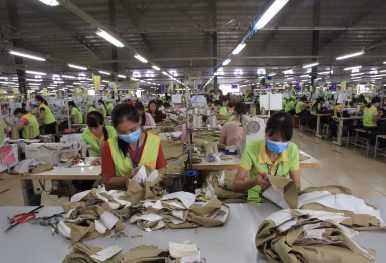By Yigal Chazan
 With the world braced for further escalations in the U.S.-China trade war, Southeast Asian economies are experiencing some benefit from the dispute, which appears to be accelerating the relocation of manufacturing capacity from the Chinese mainland to the region.
With the world braced for further escalations in the U.S.-China trade war, Southeast Asian economies are experiencing some benefit from the dispute, which appears to be accelerating the relocation of manufacturing capacity from the Chinese mainland to the region.
While export-orientated ASEAN members are unlikely to escape the economic harm caused by the tit-for-tat tariffs imposed by Washington and Beijing on each other’s products, it may be mitigated by the shift in production, helping to sustain the region’s healthy growth – with the likes of Vietnam, whose GDP rose by 6.98 percent between January and September, an eight-year high, set to be among the main beneficiaries.
The transfer of manufacturing capacity represents something of a turnaround in fortunes for Southeast Asia, as a recent paper by the Economist Intelligence Unit (EIU), looking at the impact of the trade war on Asia, pointed out. The EIU noted that in some ways relocation is a reversal of a trend earlier this century “when China’s rise as an export powerhouse diverted investment from ASEAN economies that were still reeling from the 1997 Asian financial crisis.”
Rising land and labor costs in China have for some time been prompting foreign companies based there, along with domestic firms, to invest in factory output in Southeast Asian states, enticed by geographic proximity, lower wages, improving infrastructure as well as liberal trading policies and sizable local consumer demand. The shift has been dubbed the “China Plus One” strategy, whereby investors move some of their Chinese operations to a neighboring country in order to lower overhead.
The trend is likely to be expedited by the trade war between China and the United States, as companies based in China attempt to evade margin-squeezing tariffs. The relocation of plant capacity may at least in part account for some of the ASEAN region’s 18 percent rise in Foreign Direct Investment (FDI) in the first half of 2018. Thailand and the Philippines saw the biggest increases, with surges in manufacturing investments.
In September, an American Chamber of Commerce survey of more than 430 U.S. companies in China revealed that 18.5 percent – including those involved in consumer products, technology and telecom hardware, chemicals, and the automotive sector – had been considering transferring their manufacturing to Southeast Asia, or had already done so, due to the recent tariffs and/or concerns over the future of U.S.-China trade relations. Many Hong Kong businesses are also reportedly making plans to move their production from the Chinese mainland to Vietnam and Malaysia and other countries in the ASEAN region.
Notwithstanding the economic uncertainties associated with the spillover of market turmoil in Turkey and Argentina and higher U.S. interests rates, ASEAN members look like good relocation bets for companies wishing to limit the fallout from the U.S.-China trade war. The United States appears to be buying more and more of the region’s output. In August, U.S. imports of products from Vietnam increased by 11.3 percentcompared to the same month last year. The corresponding figures for Indonesia and Cambodia were 6.4 and 3.8 percent, respectively.
It is not just foreign companies based in China that are eyeing Southeast Asia. As of the end of last year, there were more than 4,000 Chinese firms in the region, employing about 300,000 locals – some of the operations linked to the Belt and Road initiative (BRI), according to the South China Morning Post. Indeed, economic links between the bloc and its neighbor, which have a free trade agreement and are currently negotiating a more comprehensive regional deal, are anticipated to grow significantly. In June, at bilateral talks in Singapore, ASEAN and China representatives agreed to intensify efforts to achieve their twin goals of two-way trade and investment of $1 trillion and $150 billion respectively by 2020.
Yet there are risks associated with strengthening ties. ASEAN members supplying parts for goods assembled in China could see demand for their exports slow if the United States slaps more tariffs on finished products. Also, Chinese investors that choose to transfer some or all of their production to the region in order to evade the trade war may attract the attention of U.S. regulators, as they become more alert to attempts to conceal exports’ country of origin. Relations between most Southeast Asian countries and the United States are good, but that could change if Washington felt the region was providing Beijing with an opportunity to circumvent higher tariffs.
While China-based foreign manufacturers’ relocation of production capacity is likely to boost ASEAN economies, some observers believe that this will not happen overnight. In its recent paper, the EIU suggested the upside may not come about for a few years as multinationals complete the lengthy bureaucratic process of shifting production, “As a result, the negative, disruptive effects of the trade war will predominate in the short term.” It is a salutary reminder that while some accrue benefit from trade wars, disputes like this are usually zero-sum games.
Yigal Chazan is the head of content at Alaco, a London-based business intelligence consultancy.
No comments:
Post a Comment